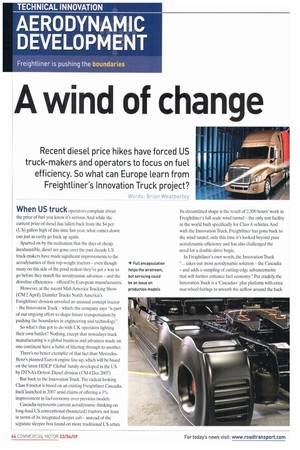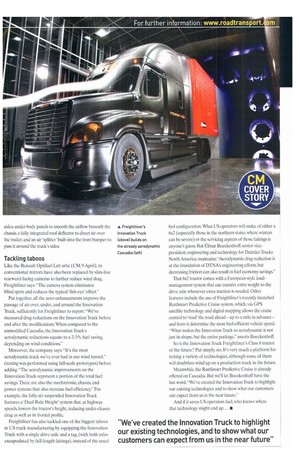A wind of change
Page 44

Page 45

If you've noticed an error in this article please click here to report it so we can fix it.
Recent diesel price hikes have forced US truck-makers and operators to focus on fuel efficiency. So what can Europe learn from Freightliner's Innovation Truck project?
When US truck operators complain about the price of fuel you know it's serious And while the current price of diesel has fallen back from the $4 per (US) gallon high of this time last year, what comes down can just as easily go back up again.
Spurred on by the realisation that the days of cheap, inexhaustible, diesel are gone, over the past decade US truck-makers have made significant improvements to the aerodynamics of their top-weight tractors — even though many on this side of the pond reckon they've got a way to go before they match the aerodynamic advances — and the driveline efficiencies — offered by European manufacturers.
However, at the recent Mid-America Trucking Show (CM2 April), Daimler Trucks North America's Freightliner division unveiled an unusual concept tractor — the Innovation Truck — which, the company says "is part of our ongoing effort to shape future transportation by pushing the boundaries in engineering and technology".
So what's that got to do with UK operators fighting their own battles? Nothing, except that nowadays truck manufacturing is a global business and advances made on one continent have a habit of filtering through to another.
There's no better exemplar of that fact than MercedesBenz's planned Euro-6 engine line-up, which will be based on the latest HDEP 'Global' family developed in the US by DTNA's Detroit Diesel division (CM 4 Dec 2007).
But back to the Innovation Truck. The radical-looking Class 8 tractor is based on an existing Freightliner Cascadia, itself launched in 2007 amid claims of offering a 3% improvement in fuel economy over previous models Cascadia represents current aerodynamic thinking on long-haul US conventional (bonneted) tractors, not least in terms of its integrated sleeper cab — instead of the separate sleeper box found on more traditional US artics. Its streamlined shape is the result of 2,500 hours' work in Freightliner's full-scale wind tunnel — the only test facility in the world built specifically for Class 8 vehicles. And with the Innovation Truck. Freightliner has gone back to the wind tunnel, only this time it's looked beyond pure aerodynamic efficiency and has also challenged the need for a double-drive bogie.
In Freightliner's own words, the Innovation Truck "...takes our most aerodynamic solution — the Cascadia — and adds a sampling of cutting-edge advancements that will further enhance fuel economy". Put crudely, the Innovation Truck is a `Cascadia+' plus platform with extra rear-wheel fairings to smooth the airflow around the back
axles, under-body panels to smooth the airflow beneath the chassis. a fully integrated roof deflector to direct air over the trailer, and an air `splitter' built-into the front bumper to pass it around the truck's sides.
Tackling taboos
Like the Renault Optifuel Lab artic (CM, 9 April), its conventional mirrors have also been replaced by slim-line rearward-facing cameras to further reduce wind drag. Freightliner says: "The camera system eliminates blind spots and reduces the typical fish-eye' effect."
Put together, all the aero-enhancements improve the passage of air over, under, and around the Innovation Truck, sufficiently for Freightliner to report: "We've measured drag reductions on the Innovation Truck before and after the modifications. When compared to the unmodified Cascadia, the Innovation Ruck's aerodynamic reductions equate to a 2-3% fuel saving, depending on wind conditions."
Moreover, the company says: "It's the most aerodynamic truck we've ever had in our wind tunnel," (testing was performed using full-scale prototypes) before adding: "The aerodynamic improvements on the Innovation Truck represent a portion of the total fuel savings.There are also the mechatronic, chassis, and power systems that also increase fuel efficiency." For example. the fully-air suspended Innovation Truck features a 'Dual Ride Height' system that, at highway speeds, lowers the tractor's height, reducing under-chassis drag as well as its frontal profile.
Freightliner has also tackled one of the biggest taboos in US truck manufacturing by equipping the Innovation Truck with a single drive-axle and a tag, (with both axles encapsulated by full-length fairings), instead of the usual AL Freightliners 6x4 configuration. What US operators will make of either a Innovation Truck 6x2 (especially those in the northern states, where winters (above) builds on can be severe) or the servicing aspects of those fairings is the already aerodynamic anyone's guess. But Flmar Boeckenhoff, senior vice Cascadia (left) president, engineering and technology for Daimler Trucks North America, maintains: "Aerodynamic drag reduction is at the foundation of DTNA's engineering efforts, but decreasing friction can also result in fuel economy savings."
That 6x2 tractor Comes with a European-style loadmanagement system that can transfer extra weight to the drive axle whenever extra traction is needed. Other features include the use of Freightliners recently launched RunSmart Predictive Cruise system, which, via GPS satellite technology and digital mapping allows the cruise control to 'read' the road ahead up to a mile in advance — and from it determine the most fuel-efficient vehicle speed. "What makes the Innovation Ruck so aerodynamic is not just its shape, but the entire package," asserts Boeckenhoff.
So is the Innovation Truck Freightliners Class 8 tractor of the future? Put simply, no. It's very much a platform for testing a variety of technologies, although some of them will doubtless wind up on a production truck in the future.
Meanwhile, the RunSmart Predictive Cruise is already offered on Cascadia. But we'll let Boeckenhoff have the last word. "We've created the Innovation Thick to highlight our existing technologies and to show what our customers can expect from us in the near future."
And if it saves US operators fuel, who knows where that technology might end up... III
















































































































































